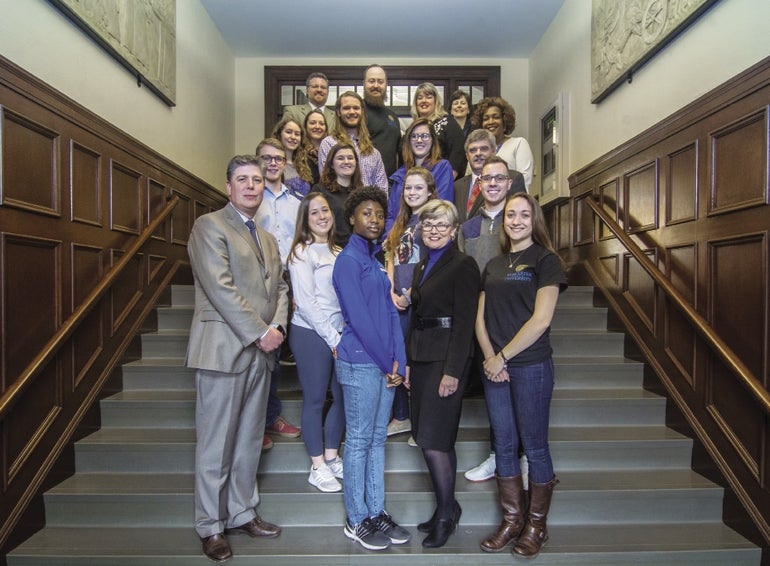When Barry Maloney became the Worcester State University president in 2011, he made a point of converting the school’s board of trustees and executive team to closely match the makeup of the majority-female student body.
Maloney’s initiative has worked.
Five of Worcester State’s top nine administrators in Maloney’s cabinet are women, and Maloney has appointed all but one of them. Eight members of the school’s 11-person board of trustees are women.
“Given that our student body is roughly 60-percent female and 40-percent male, it’s great to have a board that reflects that breakdown,” Maloney said.
Of the 75 Central Massachusetts organizations examined by WBJ for its The Boardroom Gap series about gender diversity in business leadership, 19 had at least 40 percent women among their senior executives and members of boards of directors.
Among those leaders, organizations like WSU, Heywood Hospital and Fitchburg State University prioritized hiring women into those senior roles in order to match the gender makeup of either their employee or customer bases.
And those organizations were able to switch from male-dominated leadership to be more gender inclusive not by always picking the female candidates, but by expanding their candidate pools to be more inclusive of varying backgrounds and expertises.
“I don’t want to sound like a cliche,” Maloney said, “but I hired the best people that presented themselves.”
Creating a diverse candidate pool
Since he took over as president and CEO of Heywood Hospital in Gardner in 2011, Winfield Brown has purposely made the gender mix among leadership match the predominantly-female workforce, including having women in 18 of 24 director-level management positions.
“Women are very holistic in how they look at our organization,” Brown said, calling the better gender diversity a benefit for the hospital’s leadership.
Brown created more gender diversity by emphasizing promoting workers with clinical backgrounds – typically women – into leadership roles.
“They know why we’re in the business of caring, and they want to find the best way of delivering that care,” he said.
Fitchburg State University President Richard Lapidus said the school has been fortunate to have a wide range of candidates since he started in the position in 2015. His nine-member team includes four women.
“In all cases, we’re always looking for those who are best for the job,” Lapidus said, “but it’s important at the same time to make sure we try to cast a wide net and be as inclusive as possible.”
Women make up 53 percent of Fitchburg State’s undergraduates and 77 percent of graduate students.
In order to increase the gender diversity among WSU’s leadership, Maloney said when positions open on the board of trustees he’s made it a practice to submit a diverse pool of candidates for consideration to be appointed by the governor.
For WSU’s administrative positions, Maloney makes sure to have have a diversity of members on search committees. He’s hired four female administrators and two male administrators.
Spectrum Health Systems, a Worcester-based inpatient and residential health treatment nonprofit, has seven women among its top 11 executives, including its chief financial officer and chief operating office.
“If you have a group of homogenous people around a conference room, and all thinking the same way, you’re only going to get one answer and one solution to a problem,” Kurt Isaacson, Spectrum’s president and CEO since 2016.
Gender diversity among Spectrum’s leadership mirrors its workforce as a whole, which is 60 percent female. Women tend to make most of the healthcare decisions for their family, he said, and having more women in the executive ranks helps bring what Isaacson called “emotional literacy.”
“They’re more expressive about their passion for the business and its mission, whereas men are more reserved,” Isaacson said.
Maloney said as WSU’s leadership has become more gender balanced, the organization has attracted more candidates who value that quality.
The same is true at Nitsch Engineering, a private company founded by Worcester Polytechnic Institute graduate Judith Nitsch in 1989. Nitsch has worked to appoint women to roles that might often otherwise go to men. The company has flexible schedules for families, and has women in 39 percent of its engineering positions, double the national average, she said.
“We are pretty different as far as firms go,” Nitsch said. “Women seek us out because they see women at the top.”
Read the entire Boardroom Gap series
Feb. 5 edition
– WBJ’s Findings: Women vastly underrepresented in Central Mass. corporate leadership
– The Pay Gap: Central Mass. male executives make $1.3M vs. $573K for women
– Editorial Opinion: The importance of diversity
– Letter from the Editor: Can’t keep doing the same thing and expect different results
Feb. 19 edition
– Feeling Marginalized: Central Mass. businesswomen who’ve sat in positions of power say they don’t get the same automatic credibility as men
– Gender Diversity = Profits: Companies with a greater mix of women in leadership perform better
March 5 edition
– Narrowing the Boardroom Gap: Financial, legislative and cultural pressures are creating more gender diverse business leadership
– The Best Candidate Gets the Job: Diverse candidate pools lead to diverse companies, leading local firms say
– Letter from the Editor: Now comes the hard part
– Viewpoint Opinion: Women of color need to break the concrete ceiling

